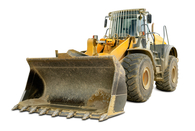Buyer's Guide
Bulldozers Introduction
Bulldozers mount a powerful engine and hydraulic blade on wide, ground-gripping tracks, making them useful for clearing debris, moving soil or loose materials, grading, and even cutting brush or tree stumps.

Bulldozers range in size from 40 horsepower (hp) to 400 hp or more. The 100 to 240 hp range is the most common for general-purpose bulldozing. Even larger bulldozers are primarily used in mining, expansive recycling or trash operations, and other large-scale operations.
The main advantage of the bulldozer's treads is the traction they provide in mud or loose terrain. In addition, because the weight of the bulldozer is distributed across a large area, they tend to do less damage to the surfaces they work on than their substantial weight would suggest.
For more "float" - ability to stay on top of loose surfaces - look for bulldozers with extra-wide tracks to take this advantage to its fullest.
Selecting Bulldozer Blades
Make sure the bulldozer you purchase has the right blade for your most common uses, whether that's fine grading or deep cutting. Universal blades (U-blades) are curved and have "wings" to hold more material; straight blades (S-Blades) which have no wings or curvature are best for grading; and combination "S-U" blades are designed to push smaller piles of heavier materials. Sharper blades are well-suited for cutting tree stumps and clearing brush.
Bulldozers don't change attachments the way backhoe loaders or skid steers do - while it's possible, you'll never use a bulldozer as a tool carrier. If you're looking for a tracked vehicle that can wield a variety of attachments, you need a compact track loader.
Size considerations
Make sure you note the physical size of the bulldozers you're evaluating. Bulldozer blades can range from just over 9' to more than 14' wide; protective cabs can be 8' to 12' high. Knowing your height and width limitations is a very simple way to narrow your choices, so measure any gates, garages, or other small spaces the bulldozer needs to fit through.
Evaluating Bulldozer Models
Once you've narrowed down your choices to some bulldozers that are the right size for your needs, take them for a test drive. Keep these factors in mind as you're comparing each model:
- Comfort. A dozer operator may be in the cab for hours at a stretch. Is the seat comfortable? Are controls easy to reach and use? Is it easy to get in and out?
- Visibility. A good field of vision can speed work and reduce accidents. Can you see the edges of the blade from the seat? Can you see reasonably well to the sides?
- Maintenance. While tough, bulldozers do require constant maintenance. How easy is it to access the engine and hydraulic pumps? How easy is it to replace a damaged track link? What is the recommended service schedule like?
A new bulldozer in the 100 to 200 hp range can cost $75,000 or more, so finding a trustworthy dealer is essential. Generally, new bulldozers start around $30,000, but you can find used bulldozers for much less.